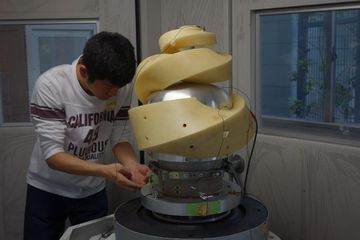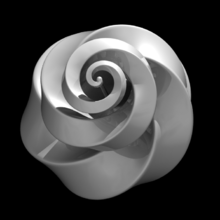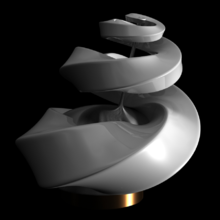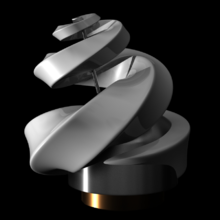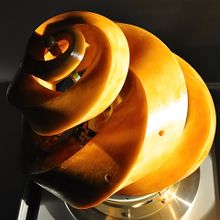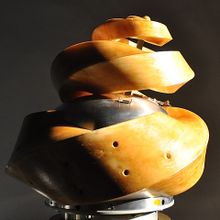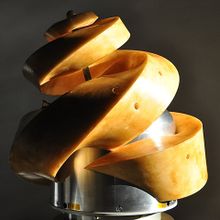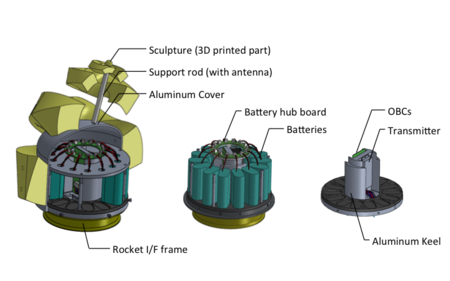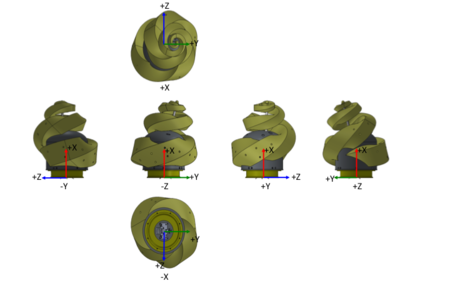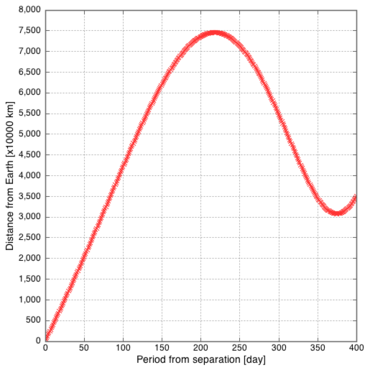Main Page
"DESPATCH" (DEep SPace Amateur Troubadour’s CHallenge) is the second spacecraft in the ARTSAT series. This spacecraft will be launched into an Earth escape trajectory November 2014, along with the Hayabusa-2 asteroid probe. In this page, DESPATCH design, subsystems, and trajectory are detailed.
As a main mission of DESPATCH, we attempt to collect signals from the spacecraft received not only at our own radio station in Tokyo, but at many ham radio stations around the world to reconstruct them back into the original data from the spacecraft. In the following page, the details of the experiment and how to join it are explained.
ARTSAT project
The “ARTSAT: Art and Satellite Project” utilizes a satellite orbiting Earth as a “medium that connects everyday life to the space.” In the course of the project, a variety of interactive works of media art and other artworks are being created. The project is carried out in a collaborative effort around a core team of over 70 members from Tama Art University and The University of Tokyo. The latter team designs and develops satellites and spacecrafts for artistic missions, while the team from Tama Art University is in charge of producing works based on data from the satellite, operating a ground station, and distributing data.
ARTSAT2: DESPATCH
"ARTSAT2: DESPATCH" is the second mission of the ARTSAT project. This spacecraft, 50x50x45 cm in size with a mass of 32 kg has a helix-shaped segment making it a beautiful sculpture. DESPATCH will be launched into an Earth escape trajectory at November 30, 2014 13:24:48, JST (UTC+9).
Missions
DESPATCH has both artistic and technical missions, as described below.
- Artistic missions:
- To create a "deep-space sculpture” by launching the spacecraft into an Earth escape trajectory
- To create “generative poetry" in the deep space and transmit the poetry from the spacecraft for reception on Earth
- Technical missions:
- To experiment with the possibilities of receiving very weak signals using a "cooperative diversity communication" approach, in which fragmented transmissions sent from the spacecraft are received around the world, gathered, and reconstructed
- To test the use of 3D-printed parts for spacecraft
One of the artistic missions, ”generative poetry,” is a broadcast of sentences in English. They are automatically generated by software running on the spacecraft’s on-board computer (OBC). The poetry generator is “seeded” using sensor readings such as temperature, angular velocity of the spacecraft, etc. For details of the "generative poetry" and "cooperative diversity communication," please see the following page.
Features
To complete these missions, DESPATCH will be operating under three unusual parameters:
- The spacecraft will transmit the signals for only a week until it reaches a distance of 2.5 million km from Earth
- It is battery-powered (rather than solar-powered) enabling a highly flexible design
- No uplink command will be sent to the spacecraft — the unit being designed to operate autonomously
構造とデザイン
DESPATCHの構造は、大きく以下の3つの部分からなる。
- 宇宙機全体を覆うような造形部(Sculpture)
- データ処理用のOBCと通信機および1次電池を収納するアルミニウム製容器(Aluminum Cover)
- 造形部を支持しアンテナを据え付ける棒状部材(Support rod)
外観のデザイン
構造系のうち造形部については、 ロシア・アヴァンギャルドの芸術家ウラジーミル・タトリンが1919年に構想した「第三インターナショナル記念塔(The Monument to the Third International)」や、 ロバート・スミッソンによるランドアートの先駆的な作品である「スパイラル・ジェティ(Spiral Jetty)」を参照・引用し、 「螺旋」をモチーフに造形のスタディを行った。螺旋は芸術作品のみならず、生命や自然の中にも多く見られる普遍的な形である。いくつかの試行錯誤の結果、最終的な造形は、以下のような特長を持つ下図のものに決定した。
- 視点の位置によってさまざまな表情の変化が生まれる
- アルゴリズミックな形状とオーガニックな風合いを融合する
造形部はCADでデザインされ3Dプリンタによりナイロンから出力されたものであり、重量はおよそ15kgと宇宙機の重量の約半分を占める。 3Dプリンタによる造形は、SOLIZE株式会社に依頼した。
以下のページでは、DESPATCHの3Dモデルをドラッグ/スクロールで操作し、様々な角度から宇宙機の多様な外観をみることができる。
- CGによるDESPATCHの外観
- DESPATCHのフライトモデル(実物)の外観
構造設計と機器配置
宇宙機の内部構造は下図に示すとおりである。 DESPATCHの構造設計においては、その外見だけではなく内部構造も美しく設計することを目標とした。 DESPATCHの構造は従来の宇宙機や衛星に多く見られるパネル・フレームの構造とは異なり、 中央のアルミニウム製支柱(Aluminum Keel)を大黒柱とした周方向に対称な構造(および機器配置)になっている。 このような周方向に対称な構造によって、振動や荷重に対する強度に方向性がない、工学的な観点からも非常に強い構造を実現している。
造形部(Sculpture)の材質はナイロン12であるが、その強度は他の金属部品と比べると弱いため、
造形部とアルミニウム製容器(Aluminum Cover)は合計17本のボルトでとめられ力が分散する構造となっている。
アルミニウム製容器は基本的に曲面となっているが,そのボルト締結部においてはナットを平面で支えるために17箇所1つ1つに特殊加工によって平面が設けられている。
また、造形部を支える棒状部材(Support rod)は、打ち上げ時の振動やロケットからの分離衝撃に耐えうる荷重・振動特性等を考慮し、材料(GFRP)やその太さが選定されている。
この棒状部材は支持部材であると同時に、モノポールアンテナの取り付け場所としての役割を持つ。
これらの構造設計および製作は株式会社由紀精密に協力をいただいた。
電気的な構成
通信系
DESPATCHのメインミッションである共同受信ミッションを成功させるためには、なるべく多くのアマチュア無線家の受信協力が必要となる。 そこで、送信電波の周波数としては、アマチュア衛星で最も一般的に使用され、より局数の多い430MHz帯を採用している。
変調方式としては最もシンプルな方式であるCW(搬送波のオン/オフで、1ビットを表現)を採用し、 複雑な変調方式の電波を低出力で送るのではなく、できる限りシンプルな変調方式の電波をできる限り高出力で送ることによって受信の確実性を高めるという設計としている。 また、シンプルな変調方式を採用する副次的な効果として、なるべく多くの方に共同受信に参加していただけるようにするだけでなく、受信の際に各局で独自に工夫を凝らすことが比較的容易であるため、地上局の多様性を利用した異種冗長化を図れると考えている。
このような設計にしたがって、以下に示す諸元の送信機を宇宙機に搭載する。 この送信機は、株式会社西無線研究所によって設計・開発されたものである。
| 送信機出力 | 7 W |
| 送信周波数 | 437.325 MHz |
| 変調方式 | CW |
| 電源電圧 | +7V DC |
| 消費電力 | 最大 24.5 W |
| 周波数安定度 | 最大 ±0.3ppm (±130 Hz) |
この送信機は宇宙機搭載のタイマーICと計算機によって駆動され、およそ7Wの送信電力がモノポールアンテナから放射される。 シミュレーションによって求めたアンテナパターンを図に示す。 なお、このアンテナは、造形部の中心に配置されたGFRP製の棒状部材に取り付けられており、 棒状部材は造形部の先端と通信機等が格納されているアルミニウム製の容器とを接続している。
- DESPATCHのアンテナパターンおよびそれを規定する座標系
参考として、この送信系とARTSATプロジェクトの地上局での回線計算の結果を、以下のファイルに記載した。
なお、このCW送信機によって送信するデータの具体的な形式については、以下のページを参照されたい。
投入軌道
DESPATCHは地球脱出軌道に投入され、ちょうど地球の横を並走するような人工小惑星となる。 その軌道は下図に示すとおりであり、打ち上げからおよそ1年ごとに地球に最接近する。 なお、図に示した緑色の軌道は、DESPATCHが相乗りする小惑星探査機はやぶさ2の目標天体(小惑星1999JU3)の軌道である。
地上から観測するとき、DESPATCHは他の惑星と同様に数時間かけてゆっくりと天球上を移動する。
以下のウェブページにて、地上の任意の地点からDESPATCHがみえる時間と方角を予測することができる。
リンク
- ARTSATプロジェクト公式HP
- SNS
- GitHub
連絡先
info@artsat.jp

